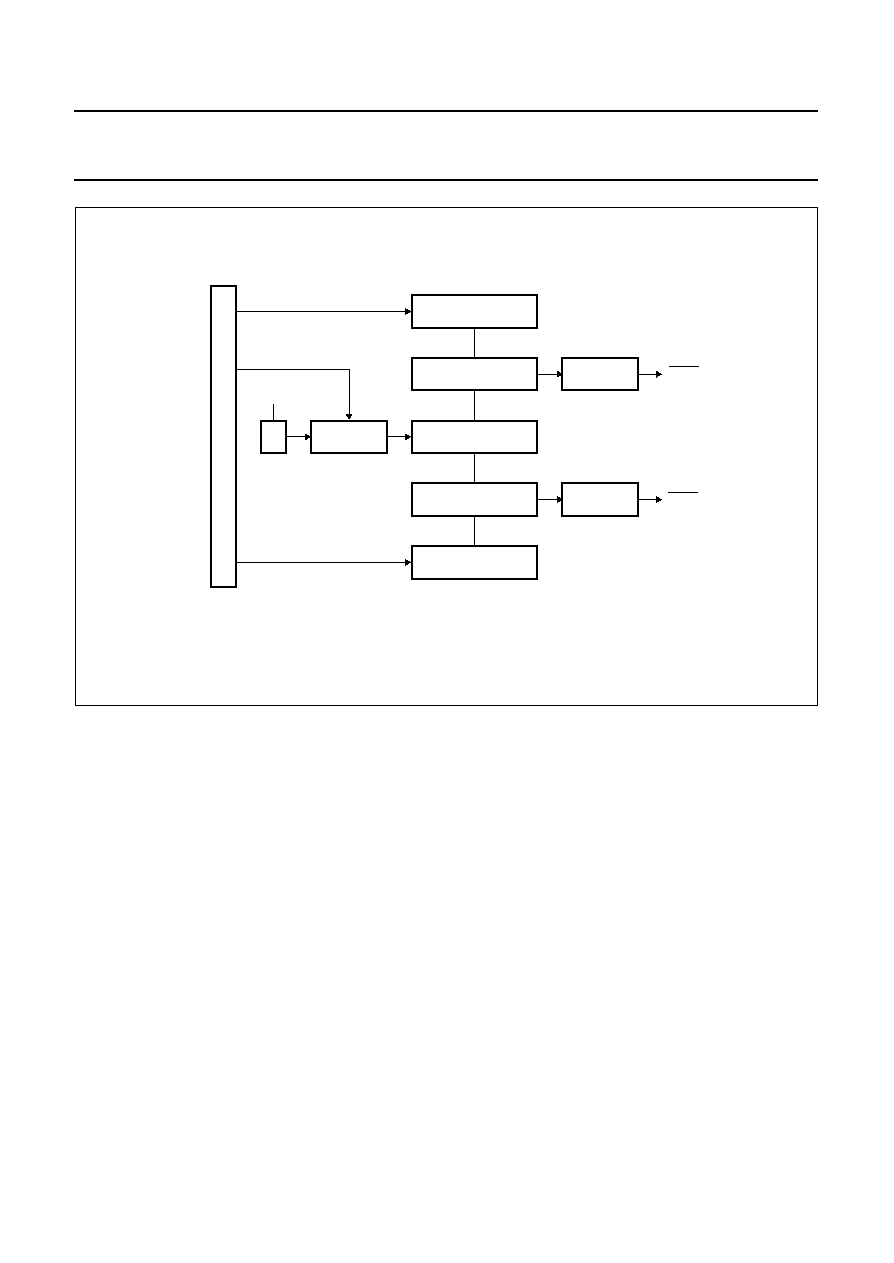- 您現(xiàn)在的位置:買賣IC網(wǎng) > PDF目錄24774 > 935086530518 (NXP SEMICONDUCTORS) 8-BIT, 16 MHz, MICROCONTROLLER, PQCC68 PDF資料下載
參數(shù)資料
| 型號: | 935086530518 |
| 廠商: | NXP SEMICONDUCTORS |
| 元件分類: | 微控制器/微處理器 |
| 英文描述: | 8-BIT, 16 MHz, MICROCONTROLLER, PQCC68 |
| 封裝: | PLASTIC, LCC-68 |
| 文件頁數(shù): | 23/112頁 |
| 文件大小: | 693K |
| 代理商: | 935086530518 |
第1頁第2頁第3頁第4頁第5頁第6頁第7頁第8頁第9頁第10頁第11頁第12頁第13頁第14頁第15頁第16頁第17頁第18頁第19頁第20頁第21頁第22頁當(dāng)前第23頁第24頁第25頁第26頁第27頁第28頁第29頁第30頁第31頁第32頁第33頁第34頁第35頁第36頁第37頁第38頁第39頁第40頁第41頁第42頁第43頁第44頁第45頁第46頁第47頁第48頁第49頁第50頁第51頁第52頁第53頁第54頁第55頁第56頁第57頁第58頁第59頁第60頁第61頁第62頁第63頁第64頁第65頁第66頁第67頁第68頁第69頁第70頁第71頁第72頁第73頁第74頁第75頁第76頁第77頁第78頁第79頁第80頁第81頁第82頁第83頁第84頁第85頁第86頁第87頁第88頁第89頁第90頁第91頁第92頁第93頁第94頁第95頁第96頁第97頁第98頁第99頁第100頁第101頁第102頁第103頁第104頁第105頁第106頁第107頁第108頁第109頁第110頁第111頁第112頁

1996 Jun 27
18
Philips Semiconductors
Product specication
8-bit microcontroller with on-chip CAN
P8xC592
Fig.9 Functional diagram of Pulse Width Modulated outputs.
handbook, full pagewidth
MGA154
I
N
T
E
R
N
A
L
B
U
S
fclk
PWMP
PWM1
PRESCALER
8-BIT COUNTER
1/2
PWM0
8-BIT COMPARATOR
OUTPUT
BUFFER
PWM1
OUTPUT
BUFFER
PWM0
10 ANALOG-TO-DIGITAL CONVERTER (ADC)
The analog input circuitry consists of an 8-input analog
multiplexer and an ADC with 10-bit resolution. The analog
reference voltage and analog power supplies are
connected via separate input pins. The conversion takes
50 machine cycles i.e. 37.5
s at 16 MHz oscillator
frequency. The input voltage swing is from 0 V to AVDD.
The ADC is controlled using the ADCON control register.
Register bits ADCON.0 to ADCON.2 select the input
channels of the analog multiplexer (see Fig.10).
The completion of the 10-bit analog-to-digital conversion is
flagged by ADCI in the ADCON register and the result is
stored in the SFR ADCH (upper 8-bits) and the 2 lower bits
(ADC.1 and ADC.0) in register ADCON.
An analog-to-digital conversion in progress is unaffected
by an external or software ADC start. The result of a
completed conversion remains unchanged provided
ADCI = HIGH. While ADCI or ADCS are HIGH, a new ADC
START will be blocked and consequently lost. An
analog-to-digital conversion already in progress is aborted
when the Idle or Power-down mode is entered.
The result of a completed conversion (ADCI = HIGH)
remains unaffected during the Idle mode.
The LOW-to-HIGH transition of STADC is recognized at
the end of a machine cycle and the conversion
commences at the beginning of the next cycle. When a
conversion is initiated by software, the conversion starts at
the beginning of the machine cycle following the
instruction that sets ADCS.
The next two machine cycles are used to initiate the
converter. At the end of this first cycle, the ADCS status
flag is set to HIGH while the conversion is in progress.
Sampling of the analog input commences at the end of the
second cycle.
During the next eight machine cycles, the voltage at the
previously selected pin of Port 5 is sampled and this input
voltage should be stable in order to obtain a useful sample.
In any case, the input voltage slew rate must be less than
10 V/ms (5 V conversion range) in order to prevent an
undefined result. The conversion takes four machine
cycles per bit.
相關(guān)PDF資料 |
PDF描述 |
|---|---|
| 935266795557 | 8-BIT, MROM, 16 MHz, MICROCONTROLLER, PQCC68 |
| 935086530512 | 8-BIT, 16 MHz, MICROCONTROLLER, PQCC68 |
| 935210470512 | 8-BIT, OTPROM, 16 MHz, MICROCONTROLLER, PQCC68 |
| 935089010512 | 8-BIT, 16 MHz, MICROCONTROLLER, PQCC68 |
| 935085020512 | 8-BIT, OTPROM, 16 MHz, MICROCONTROLLER, PQCC68 |
相關(guān)代理商/技術(shù)參數(shù) |
參數(shù)描述 |
|---|---|
| 935087-000 | 制造商:TE Connectivity 功能描述:301A511-51-05/164-0 - Bulk |
| 935087N001 | 制造商:TE Connectivity 功能描述:301A511-51-05/164-CS7092 制造商:TE Connectivity 功能描述:301A511-51-05/164-CS7092 - Bulk |
| 9350DC-200-0GZZZA | 制造商:Siemens 功能描述: |
| 9350DC-200-0ZZZTA | 制造商:Siemens 功能描述: |
| 9350DC-200-0ZZZZA | 制造商:Siemens 功能描述: |
發(fā)布緊急采購,3分鐘左右您將得到回復(fù)。